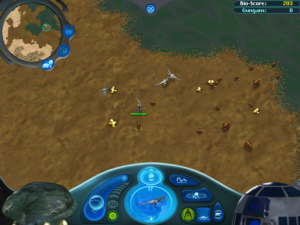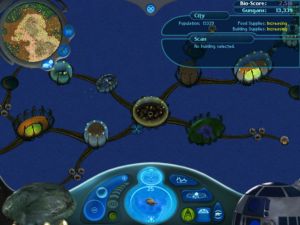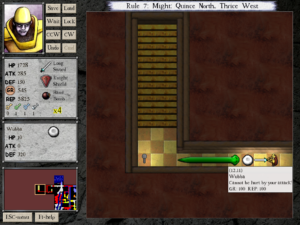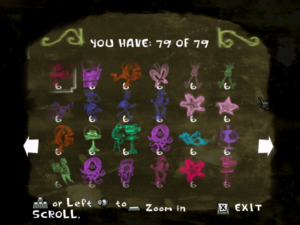Advent Rising: Ending
In some ways, Advent Rising is a better Jedi Knight than the Jedi Knight games. It has a lot to do with not having any obligation to stick to an established fictional milieu, in either detail or in philosophy. For example, in a Star Wars game, using Force powers for direct attack is the province of the Dark Side. Advent Rising doesn’t care about that: Gideon is the good guy purely on the basis that he’s trying to save the human race from destruction at the hands of cruel and merciless alien invaders, and if he chooses to kill his enemies with energy blasts from his hands rather than energy blasts from zap guns, no one is going to take him to task for it. And without the need for a distinct class of white magic, the designers are free to weaponize the utility spells. The jumping power, at higher levels, includes the option to produce a powerful shockwave on landing. The level design keeps on including stretches set on cliffs or bridges or inside tall buildings with large plate glass windows just to give you the opportunity to hurl enemies to their doom with your telekinesis.
But there’s enough Star Wars in the mix to keep reminding me of it. There’s one boss fight on a rooftop against a singularly unpleasant-looking alien, a sort of skeletal she-demon with a metal plate where you’d think her eyes should be, who attacks with both a zap gun and lightning-fast alien kung fu (including moves that can’t be performed without a tail). Despite the difference in appearance, it doesn’t take long to realize that she’s basically Boba Fett. You can’t just knock her off the roof because she has a jetpack. If you manage to land a hit on her, she jumps off the roof of her own accord, only to rise up a moment later in a small spacecraft and attempt to blast you with its cannons. When you finally drive her away, she even comments that she wanted to take you alive, as if some unknown Jabba-analog wants you frozen in carbonite on his wall.
The real reason she wanted Gideon alive didn’t occur to me until well after completing the game. I suppose I should have noticed what was going on sooner, because most of the clues were there in front of me. I’m going to describe the ending, and that will require describing the beginning, because the ending pays off a mystery established in the opening cutscene and then forgotten by the player. Basically, the opening cutscene shows a brief and wordless confrontation between some serious-looking floating bald-headed guys in long, flowing garments in some sort of weird and indeterminate glowy orange place. There is no obvious connection between this scene and the following scene of Gideon’s shuttle arriving at the space station, or indeed with most of the game that follows.
Now, the ending. Like Prince of Persia (2008) would later do, Advent Rising takes the tricky approach of putting the real ending after the closing credits. But where PoP was subtle about it, letting the player not just figure out what to do next but figure out that there was anything to do (the main hint being that the game was still letting you walk around), Advent Rising just throws you into a sudden and unexpected additional boss fight. It starts with what seems like just a bonus cinematic and sequel hook: a cutscene of the good guys finally arriving at the Galactic Senate to testify against the Seekers, who apparently have been doing their genocide and planet-busting in secret while presenting a benevolent face to galactic society at large. (This is the one Star Wars riff that seemed most drawn from the prequel trilogy.) The presentation of a living human causes a stir, but Gideon’s thunder is quickly stolen by the arrival of a “real” human — which is to say, one of the bald-headed guys from the opening, floating and radiant and looking far more worthy of being worshiped as a god by aliens than Gideon is. This new arrival calls Gideon’s people subhuman savages who tried to usurp their betters, and explains that, while it’s true that the Seekers made war on these mere primates, it’s entirely alright because it was done on the real humans’ behalf.
And for a moment, I had the thought: what if he’s right? What if this creature is what all the legends about humans had in mind all along? Just because the translator devices render the aliens’ word for their legendary space gods as “human” doesn’t mean that humans really are their legendary space gods. (It’s made explicit that the translators are programmed by feeding them a large quantity of language data. False assumptions could contaminate such a process.)
The one thing that didn’t quite make sense to me was that Gideon recognized the floating bald-headed person. When it arrives, Gideon says “Ethan?”, and when he defeats it, he says “You may have my brother’s face, but you’re not him”, both comments referring to his brother who got left behind on the space station when it was destroyed in the first chapter. (Well, actually, that doesn’t necessarily happen: you have the option of saving Ethan at the cost of losing Olivia, Gideon’s fiancee. Apparently if you do this Gideon recognizes the interloper as Olivia instead.) This reaction seemed strange to me, because I, the player, didn’t recognize the floating guy at all. At the time, I thought there might be some kind of illusion or mind-control mojo going on, making Gideon see a resemblance that wasn’t there — which would be a strange separation of player knowledge from avatar knowledge for so late in the game 1Usually when there’s a large gulf between what the player knows and what the player character knows, it’s at its greatest at the game’s beginning. The characters know things about their present and past situation that the player will later learn from cutscenes, and the player tends to have some advance story knowledge, if only from the title and genre. Over the course of play, the player and avatar both converge towards complete knowledge of the story. It would be interesting to see a game that goes the other way. — but now I think we’re just running into the limitations of the character models. The hair is the only thing making them recognizable, so when you take that away, you need to identify them in dialogue.
Anyway, when I think about it, I never saw Ethan die. He was last seen on a space station overrun by Seekers, who were occasionally grabbing people and scanning their brains. It’s obvious that they were looking for people with psychic potential, but now I understand why: to capture and control them, and turn them into weapons. There was an exchange when fish-alien Yoda 2He’s actually a bit of a subversion of Yoda, in that he’s considerably less powerful than Gideon after just a little training. first explains the powers to Gideon: Gideon says “So it’s a weapon”, and the response is a hesitant “…Interesting that you would draw than conclusion.” At the time, I interpreted this as “Humans are so innately violent that they see nothing but weapon potential in their magical gifts. Perhaps we were wrong to approach them”, but now I think it means he knew a little more than he was letting on about what the Seekers were doing with their abductees.
Ethan/Olivia is one of those puzzle-bosses that’s vulnerable to only one approach, or, more specifically, to only one of your powers. You get new powers at a rate of one per chapter for most of the game, and some of them have alt-fire modes, but even so, you have less than a dozen things to try here. And yet, I had to hit up a walkthrough to win. The reason is that one of the powers is misleadingly close to effective. The baddie’s chief weapon is a ball of darkness that homes in on you and passes through obstacles. It takes away most of your health with a single hit, but he takes several seconds to gather the darkness together — long enough to prepare for it. Now, one of Gideon’s powers is a sort of brief disco-ball of force that reflects projectiles. Perhaps I could use it to reflect the ball back at its thrower? Not quite: it does reflect, but it veers off in a curved path. But I found that if I stood quite close to Ethan, that curved path would orbit me a few times. If I jumped up at just the right moment, perhaps I could get that orbit to hit Ethan? I spent a long time trying to get this to work, but it simply doesn’t. Yes, you do have to swat the ball back at the boss a few times in a sort of deadly Jedi tennis, but there’s a much simpler way to do it.
This was a little disappointing, considering how most of the game allows for multiple viable approaches. Some of the early levels even let you pass by enemies without engaging them. It’s not quite stealth sections, but more just that they’re too busy fighting the people who are actually shooting at them to pay much attention to anyone who isn’t. This of course ends once they know you’re the Kwisatz Haderach, but that’s also when you start getting the choice of whether to shoot dudes or just throw them out windows.
Anyway, it’s a fairly satisfying game, even if the controls are over-complicated and the story leaves a lot unresolved. Apparently it was intended as the first part of a trilogy, but the sales figures put the kibosh on that. The art remains vibrant and compellingly composed throughout, and although the plot is cliché in outline, having a real writer on board seems to have helped a lot. In particular, although the game starts off with a race of good aliens and a race of bad aliens, it manages to give you just enough of the politics backgrounding the conflict to complicate matters. The Seekers aren’t all Seekers, and the few fish-guys who help you are rightly regarded as dangerous by many (most?) of their own people, who prefer the status quo, in which they’re not involved in a galactic war that’s arguably none of their business. I suppose that’s where it really parts ways with Star Wars, which never gave the impression that anyone other than outright villains actually thought that the Empire was a good thing.
| ↑1 | Usually when there’s a large gulf between what the player knows and what the player character knows, it’s at its greatest at the game’s beginning. The characters know things about their present and past situation that the player will later learn from cutscenes, and the player tends to have some advance story knowledge, if only from the title and genre. Over the course of play, the player and avatar both converge towards complete knowledge of the story. It would be interesting to see a game that goes the other way. |
|---|---|
| ↑2 | He’s actually a bit of a subversion of Yoda, in that he’s considerably less powerful than Gideon after just a little training. |
 Comments(2)
Comments(2)


